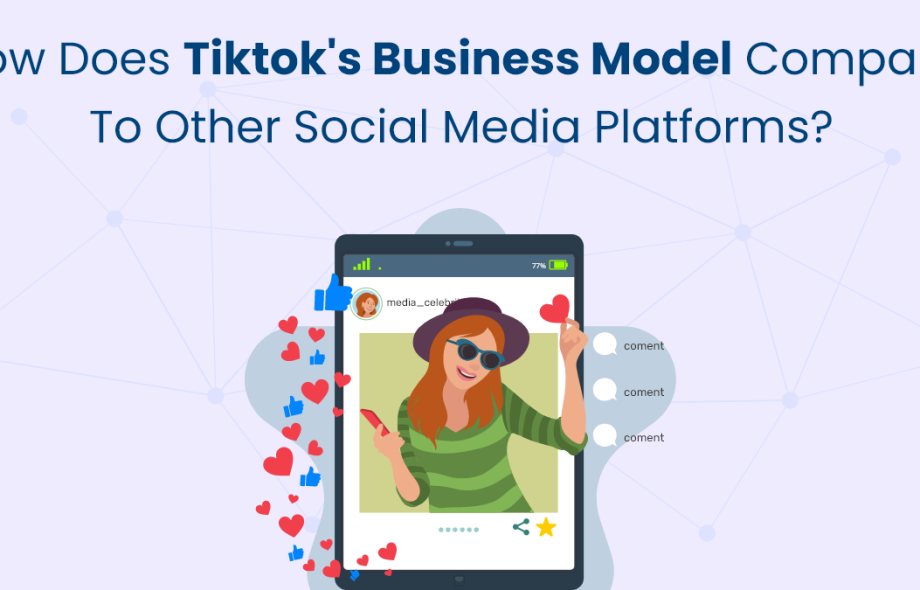TikTok has emerged as a disruptive force in the social media landscape, introducing a unique business model that sets it apart from traditional platforms like Facebook, Instagram, and Twitter. While each platform serves as a hub for content creation, community engagement, and digital marketing, TikTok’s approach to monetization, content discovery, and user interaction distinguishes it significantly. Here’s a detailed comparison of TikTok’s business model with other social media platforms:
1. Content Discovery and Algorithm
TikTok: TikTok employs a sophisticated algorithm-driven content discovery system that prioritizes personalized content recommendations on users’ “For You” pages. The algorithm analyzes user interactions such as likes, shares, comments, and viewing time to curate a tailored feed of videos that align with individual interests and preferences. This personalized approach enhances user engagement by continuously surfacing relevant and engaging content, fostering viral trends, and amplifying reach based on user behavior.
Other Platforms: Traditional social media platforms like Facebook and Instagram initially relied on chronological feeds, where content visibility depended on the time of posting. While these platforms have integrated algorithms to prioritize content based on user interactions and interests, TikTok’s algorithm is renowned for its effectiveness in surfacing viral content and discovering new creators, influencing user engagement patterns and content consumption habits.
2. User-Generated Content (UGC) and Creativity
TikTok: TikTok thrives on user-generated content (UGC), empowering users of all backgrounds to create and share short-form videos that entertain, educate, or inspire. The platform’s emphasis on creativity, music integration, and interactive features such as filters, effects, and challenges encourages spontaneous content creation and fosters a vibrant community of content creators. TikTok’s democratized approach to UGC facilitates viral content dissemination and enables individuals to achieve widespread visibility and influence organically.
Other Platforms: While other social media platforms also facilitate UGC, TikTok’s focus on short-form video content and creative expression distinguishes it from platforms that predominantly feature text-based updates, photos, or longer videos. Platforms like YouTube and Instagram support diverse content formats but differ in audience demographics, content consumption habits, and engagement dynamics compared to TikTok’s rapid-scrolling, visually-driven interface.
3. Monetization and Revenue Streams
TikTok: TikTok offers multiple monetization avenues for creators and businesses, including:
- TikTok Creator Fund: Creators earn money based on video views and engagement metrics through the TikTok Creator Fund, which distributes funds to eligible creators monthly.
- Influencer Marketing: Brands collaborate with TikTok influencers to promote products or services through sponsored content, branded challenges, and influencer partnerships.
- Advertising Solutions: TikTok’s advertising platform includes in-feed ads, branded hashtag challenges, and branded effects that enable businesses to enhance brand awareness, drive website traffic, and promote products to a targeted audience.
Other Platforms: Traditional social media platforms generate revenue primarily through advertising, sponsored content, and subscription-based models. Platforms like Facebook and Instagram offer similar advertising solutions but may differ in audience targeting capabilities, ad formats, and campaign optimization tools compared to TikTok’s interactive and creative ad options.
4. Audience Engagement and Community Dynamics
TikTok: TikTok fosters community engagement through interactive features such as likes, shares, comments, duets, and live streams. The platform’s emphasis on viral challenges, duet collaborations, and user interaction promotes community building, cultural trends, and collective creativity among users worldwide.
Other Platforms: While other social media platforms facilitate community interaction through likes, comments, and shares, TikTok’s emphasis on interactive content formats and viral challenges encourages deeper engagement and real-time interactions among users. Platforms like Twitter and LinkedIn prioritize professional networking and news dissemination, catering to distinct user behaviors and content consumption preferences compared to TikTok’s entertainment-focused ecosystem.
5. Global Expansion and Cultural Impact
TikTok: TikTok’s rapid global expansion has positioned it as a cultural phenomenon, influencing pop culture, music trends, and consumer behavior worldwide. The platform’s localization strategies, regional content trends, and community-driven content contribute to its cultural relevance and global appeal among diverse demographics.
Other Platforms: While other social media platforms have also achieved global reach, TikTok’s ability to transcend language barriers, cultural differences, and geographical boundaries through localized content and viral trends distinguishes it as a platform that fosters global cultural exchange and digital creativity.
6. Data Privacy and Platform Governance
TikTok: TikTok has faced scrutiny over data privacy concerns, particularly regarding user data collection practices and platform governance. The platform has implemented measures to enhance transparency, data security, and user control over data sharing preferences, aligning with regulatory requirements and user expectations.
Other Platforms: Data privacy and platform governance practices vary among social media platforms, with each adhering to privacy policies, data protection regulations, and user consent mechanisms. Platforms like Facebook and Twitter have also addressed data privacy concerns through enhanced security measures, privacy settings, and compliance with global data protection laws.
Conclusion
TikTok’s business model stands out from other social media platforms due to its algorithm-driven content discovery, emphasis on user-generated creativity, diverse monetization opportunities, interactive engagement features, global cultural impact, and data privacy considerations. While traditional platforms prioritize established content formats, audience demographics, and revenue streams, TikTok’s innovative approach to content consumption, community building, and digital marketing offers businesses unique opportunities to engage with a global audience, drive brand growth, and capitalize on emerging cultural trends. By leveraging TikTok’s dynamic ecosystem and creative possibilities, businesses can enhance brand visibility, foster consumer connections, and achieve sustainable business success in an evolving digital landscape.



 :
:









